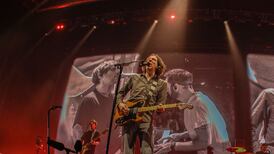Napoleon: The Spirit of the Age: 1805-1810
Michael Broers
Faber & Faber, £30
Michael Broer's second instalment of what promises to be a remarkable three-volume study is a fascinating portrait of a man caught between two worlds, a genuinely great but flawed individual who succeeded in forging "the future" from a clash between the past and the present. The author's central contention, that Napoleon . . . truly was Hegel's "spirit of the age"', is borne out by a narrative suffused with "the stuff of heroic legend . . . an epic more Wagnerian than Homeric". Accounts of military campaigns are carefully woven together to recreate a brutal, increasingly apocalyptic drama that encompasses everything from the French campfires before Austerlitz - "one of the most moving spectacles of his spectacular life" - to the blizzard-swept battlefield of Eylau, where Napoleon "was visibly shaken by the . . . blood-stained snow". Characters such as Josephine, Talleyrand, Fouché, Goethe and others move in and out of the emperor's orbit and are vividly and insightfully depicted. The result is a balanced, immensely readable work that captures the essence of a man with "a genuine capacity . . . for optimism". A tour de force of historical writing.
Freya McClements
Do I Make Myself Clear?
Harold Evans
Abacus, £12.99
In this era of "alternative facts" and "fake news", where "we're vulnerable to a fusillade of digital bullets, reckless words unmonitored, unchecked, unverified", Harold Evans, one of the great journalists of our time, makes the case for clear expression. So he urges journalists to use short words instead of long – simple instead of complex and concrete instead of abstract. He also recommends varying sentence type and style but keeping them simple and concise. His "ten shortcuts to making yourself clear" include using the active rather than the passive voice, being specific, rationing adjectives and adverbs, being positive rather than negative, putting people first in your stories and not being afraid to repeat words. He wages war on circumlocution, longwindedness, verbosity, pomposity, redundant phrases and clichés, and provides a useful guide for words commonly misused and confused. To Evans, writing well is a "moral issue" and he fears we're on the eve of the coup Orwell warned about when he wrote "emptying words of meaning is an essential step on the road to autocratic rule".
Brian Maye
Cathal Brugha
Fergus O'Farrell
UCH Press, €17
Cathal Brugha is perhaps the most enigmatic of all the members of the revolutionary government in Ireland following the general election of 1918. He left few papers for posterity. The author has used recently released papers from the Bureau of Military Archives to write the first dedicated biography of him in English. Second in command at the South Dublin Union during Easter Week in 1916, he took 25 bullets during the fighting. The author adds to our knowledge of Brugha's assassination squad that he brought to London in early 1918 during the conscription crisis. Minister for defence until the vote that approved the Anglo-Irish Treaty, he has inevitably suffered in comparison with Michael Collins, who was technically his subordinate in military matters. The author attempts to disprove the belief that Brugha was purely a physical force advocate. He also does not believe that jealousy of Collins was Brugha's motivation in advocating that the IRA be subject to his ministerial authority. His bitter personal attack on Collins during the treaty debates did nothing to enhance his reputation.
Frank MacGabhann
Nick Groom, The Vampire: A New History
Yale University Press
Positing the idea that vampires are essentially "roving thought-experiments", cultural tools used over centuries as a way of making sense of the human predicament, Exeter professor of English Nick Groom shows how these fictive beings act as the undead shadows of changes in the way humanity is defined. Charting shifts in medicine, politics, sociology, environmentalism, and psychosexual theory, Groom's eminently readable and convincing account traces 300 years of vampires, all the while considering how this monstrous figure became an unlikely hero for the marginalised in the 20th and 21st centuries. Beginning in the year 1725, when a sudden outbreak of vampires on the borders of the Habsburg Empire caught the attention of European doctors, scientists and theologians, Groom goes beyond the traditional literary study of these gothic icons, exploring their existence in folklore, early medieval science and various non-fictional sources. Printed with a number of vibrant and shocking illustrations and plates, this is a fascinating work of both cultural history and literary criticism.
Seán Hewitt
The Girl Who Smiled Beads
Clemantine Wamarya & Elizabeth Weil
Hutchinson, £14.99
Opening with a carefully curated Oprah Winfrey reunion show, this is a memoir which challenges the idea of happy-ever-after and how there can be no such thing in the aftermaths of war. In 1994, Wamarya fled Rwanda with her sister Claire. She was six years old and completely dependant on the decisions her 15-year-old sibling made. The girls shift from place to place, first relying on distant relatives and complete strangers, then long spells in refugee camps across Africa. Six agonising years were spent travelling through seven African countries; learning the many languages, traditions and expectations of each land. Eventually granted asylum in the United States, the sisters fled the memories of massacre and hoped for new beginnings. America is startlingly different and Wamarya desperately tries to find an identity in which she is not a curiosity: "I did not want to be a tool or a case study. I did not want to be that Rwandan girl." Wamariya chooses to share her experiences in a more hopeful way. Sensitive and honest, angry and arresting. An outstanding memoir.
Margaret Madden
John Joe’s Story
Stan D O'Brien
Coolfin, €20
Commandant John Joe O'Brien, whose story is well told here by his son, joined the Irish Volunteers, with his brothers Ned and Willy, shortly after their formation. From Galbally, Co Limerick, the family had a background in the land struggle and the Fenians. Willy O'Brien was among the random arrests in Limerick after the 1916 Rising; interned in Frongoch, he was released due to ill health and died soon afterwards. John Joe served with the East Limerick and South Tipperary Brigades Flying Columns in a part of the country that saw some of the most active fighting during the War of Independence. The O'Brien brothers participated in the daring rescue of Seán Hogan at Knocklong; afterwards Ned went to America where he worked with Harry Boland and became close to de Valera. John Joe was involved in many actions; the story doesn't disguise the hardships of the fight but, amazingly, he described the period as "the happiest days of my life". This is a lively, thought-provoking insight into a local side of the fight for independence.
Brian Maye





















